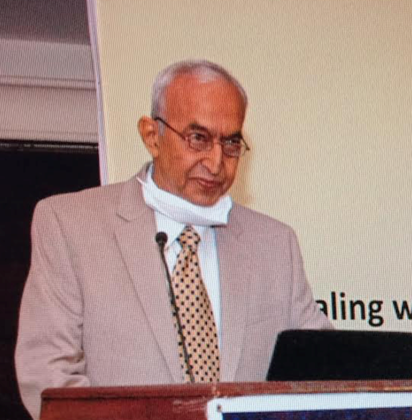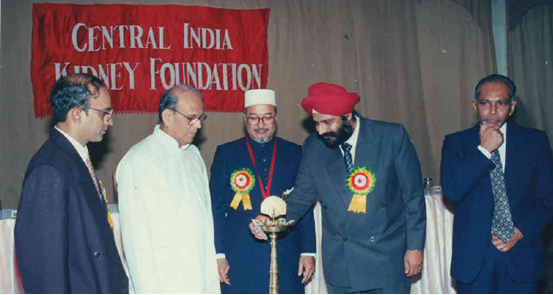Blog
Looking back
Starting Kidney Transplantation in Central India
Dr. Shivnarayan J Acharya
Future belongs to those who believe in the beauty of their dreams ….
Patients with end stage kidney disease go through immense suffering, which can be alleviated only by kidney transplantation. It provides better outcome than dialysis.
After doing my specialisation in Nephrology from Jaslok Hospital, Bombay (yes, it was not Mumbai back in the 80’s), I was at a cross road — stay back in Bombay and enter the rat race or start a practice in Nagpur, where no transplant facilities existed. The crowded local trains and busy streets of Bombay sent shivers down my spine, and I decided for the latter.
Back then, patients with end stage renal disease in the Vidarbha region had to go out of town to get treated. Only three big private hospitals existed in Nagpur — CIIMS (started by eminent neuro-physician, Dr G M Taori), Mure Memorial (a missionary hospital), and Nagrik Sahakari Rugnalaya (a trust hospital). Dialysis facility was not available in any of these multi-specialty hospitals. So there was no option but for me to start my own hospital. The problem was, I dreamt big but with empty pockets.
The journey to the first kidney transplant in Nagpur…
The journey of a thousand miles begin with one step – Lao Tzu
The journey to the first kidney transplant in Nagpur was an interesting one.
I contacted stalwart uro-surgeon Dr. Vijay Shrikhande and looked for hospitals where we could perform transplants. We zeroed in on Mure Memorial hospital, which had a good operation theatre, spacious rooms, and well-trained nurses and paramedics. However, it lacked dialysis facilities, and it was a task convincing the hospital management about the need for kidney transplantation and its associated benefits to the hospital.
Dr S N Mukherjee was the director of Mure Memorial Hospital who helped us a lot.
Those days, communication was a challenge. Telephones were a luxury. It was beyond our imagination that a day would come when telephones would be so mobile that people would carry phones in their pocket!
Load shedding was the order of the day. Load shedding used to happen without prior notice. Despite keeping the electricity department informed, we faced situations where power would go off at the most crucial moments (like vascular anastomosis!) and surgery was carried out with torchlight! Challenges were aplenty.
To conduct a transplant, we needed two basic tests — matching blood group, and CDC cross match. Till then, HLA-typing was not done routinely any where in the country. So, for CDC cross match, I had to send blood samples to Jaslok Hospital in Bombay. This was a tedious process. I used to personally pack the samples in small vials, put them in a thermos and cover them with ice to keep them cool. Patients’ relatives then took the samples to Jaslok Hospital. There were times when the immunologist would call me after a few days to inform that melted ice had percolated into the sample and contaminated it … the same process had to be repeated again.
Sonography facilities were in their nascent stage in Nagpur. Bedside sonography was not available as the machines were too big to be moved. CT scan was in a primitive stage. My friend, Dr Shrikant Kothekar, had just started working on invasive procedures like angiography. He was a big source of help for donor evaluation before transplants.
Drugs like FK506 (present-day Tacrolimus) and Mycophenolate had been invented but not yet marketed. Antithymocyte globulin, Basiliximab and Daclizumab were yet to be discovered. OKT3 was the drug used for induction but I decided against using it. Its first dose reaction had life threatening implications, which would have been difficult to manage without proper ICU facilities. We used immuno-suppressants like Prednisolone, Cyclosporine and Azathioprine.
Back then, blood banks could only provide whole blood. Leucocyte depleted packed RBC or fresh frozen plasma were not heard of until then. At the most, saline washed packed cells to remove leucocytes were available. To make matters worse, HIV infection had spread with no proper treatment available for it. We had to be very careful while using blood. Apart from HBsAg, an entity called ‘Non-A Non-B Hepatitis’ was found. This would later come to be known as Hepatitis C. There were no tests to detect it. So if SGPT level was high in the blood, we suspected ‘Non-A Non-B Hepatitis’.
Other than technical challenges, there was a shortage of resident doctors. Most hospitals were managed by nursing staff. So I prepared myself to stay in the hospital to monitor patients for the entire length of their stay at the hospital after the transplant.
With other elements in place, we constituted the surgical team. I invited Dr S S Joshi, the transplant surgeon with whom I had worked at Jaslok Hospital. Dr Chandrashekhar Thatte from Indore joined in. Dr Vijay Shrikhande and Dr Arvind Joglekar were the local surgeons. Dr A V Joshi, Dr Hemant Sane and Dr Anant Mashankar were the anaesthesiologists. This team of doctors became a part of the first ever kidney transplant in the region.
With everything in place, the first kidney transplant in Vidarbha region happened at Mure Memorial Hospital, Nagpur on 27th November 1990. The patient was a 19 years old engineering student, Zulfiquar Ali, who presented with uremic seizures. His mother was the donor. The total expenditure was Rs 22,000/- (of course with the philanthropy of all participating doctors).

First Kidney recipient, Zulfiquar along with his mother as donor, with Dr S J Acharya, transplant physician.

Transplant team in front of Mure Memorial Hospital – 1990
With the first success, people became confident with getting kidney transplants in Nagpur. In the next three years, we did 10 live related kidney transplantations at Mure Memorial Hospital. We were careful not to fall prey to unethical practices of unrelated transplants.
Our mean graft survival was more than 10 years with the help of simple immunosuppressants namely prednisolone, azathioprine and cyclosporine. Zulfiquar survived for 11 years after his transplant. However, his graft was rejected when he stopped taking immunosuppressive drugs. Our longest survival was 22 years — a lady from Chandrapur who was transplanted in 1992 with her mother’s kidney. After two decades of transplant, she succumbed to fungal pneumonia with a functioning graft.
In 1994, Parliament passed the Transplantation of Human Organs and Tissues Act, a much-needed policy to regulate how transplants should be carried out in India. It was enacted for the regulation of removal, storage and transplantation of human organs for therapeutic purposes, and for the prevention of commercial dealings in human organs. The Act required well-equipped transplant centres, which the local hospitals in Nagpur could not provide then. Therefore, the transplant program in Nagpur was halted. Between 1994 and 2000, no transplantations were done in Nagpur. Patients had to travel to Mumbai for kidney transplants, which proved to be expensive and inconvenient. In the mean time, in 1995, Bombay became Mumbai.
With the new millennium, things turned around for us. My friend, Rajiv Yashroy, was the CEO at Jawaharlal Nehru Medical College and Acharya Vinoba Bhave Rural Hospital, Sawangi. Being a kidney transplant recipient himself, Yashroy knew the pains patients had to go through. Around the same time, I met a very dynamic and proactive surgeon, Dr Sarveshwar Sahariah at a nephrology conference. Dr Sahariah readily agreed to visit Nagpur to do kidney transplants. With this, we were on the path to restart the transplant program in Vidarbha, at Sawangi, keeping all medico-legal requirements in mind.
In 2001, myself with few friends started the Central India Kidney Foundation (CIKF) with the goal of spreading public awareness about kidney diseases and transplantation. The foundation was inaugurated by former Prime Minister Mr V P Singh, in the presence of Dr Sahariah, doyen of transplant uro-surgery in India.
We started our journey in 1989, albeit slowly, but slow and steady wins the race! The race is for a healthy life of our patients suffering from kidney diseases.
Begin, be bold, and venture to be wise. It’s not because things are difficult that we dare not venture. It’s because we dare not venture that they are difficult.

Jawaharlal Nehru Medical College and Acharya Vinoba Bhave Rural Hospital , Sawangi.

The Surgeons from outside Nagpur who contributed a lot for starting transplantation program in Vidarbha.

Dr Vijay Shrikhande accepting Life Time Achievement Award in 2016 for his contribution to the cause of Nephro-urology in Central India

Dr Arvind M Joglekar

Dr Shrikant Kothekar singlehandedly managed conventional donor renal angiography for many years till CT angio came into being.

Mr Vishwanath Pratap Singh , former prime Minister of India at inaugural function of Central India Kidney Foundation. Dr S Sahariah, T S Rawal, Salimbhai Chimthanawala and Dr S J Acharya are also seen.
